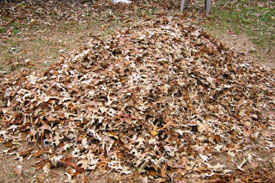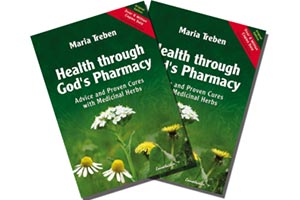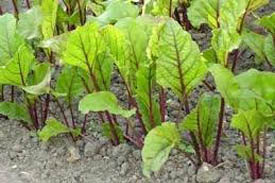Mother Nature’s Best: Leaves
 In the beginning there was a tiny acorn that was picked up by a squirrel and buried in the warm fall earth. By the following Spring the acorn sprouted, and a long, tiny root began the laborious probing, deep, and deeper, into the earth in search of moisture. Soon a sprout appeared, leaves unfolded, and the beginning of a mighty oak tree was started.
In the beginning there was a tiny acorn that was picked up by a squirrel and buried in the warm fall earth. By the following Spring the acorn sprouted, and a long, tiny root began the laborious probing, deep, and deeper, into the earth in search of moisture. Soon a sprout appeared, leaves unfolded, and the beginning of a mighty oak tree was started.
With passing time lateral roots branched out and forest nutrients were absorbed while the primary root went deeper, and deeper, into the earth in search of more moisture.
In time, perhaps 300 years, the mighty oak had reached early maturity with a tree cover of 25 yards and a root spread of 300 yards; how deep we will never know, but roots never stop their quest for feeding.
This English Oak may live, if undisturbed by the wood cutter, for a thousand years and within its lifetime will bring up tons and tons of nutrients into its leaves, wherein they, in concert with the sunshine, develop sugars, nitrogen, phosphates and potash traces from long past fires. These leaves of course drop lovingly to the ground in the fall and then Natures True Master Gardeners take over: the earthworms, bacteria and microbes.
The earthworms rise to the soil surface at night, especially with a gentle rain and heavy dew. They silently glean each leaf and return to their burrow hole to take the leaf food deep, into the earthy surface where the lateral roots are fed by the worm castings-the richest organic material on this planet.
Residual decomposing leaves are often attacked by soil organisms to further break down the organic materials to a lush fertile surface. It takes a century to create ½” of this black earth and if you scratch gently under the wet leaves you will find this developing soil.
With time much of this rich earth is washed away into lower bottomlands, and sometimes down the creeks to rivers, where it is deposited in flood prone zones-the natural way of Mother Nature. Some of it makes its way to the ocean to feed aquatic small life therein.
Mankind has sought out these rich deposits of bottomlands, and within a course of a few short years, denuded and exhausted the soils. For the past 100 years he has tried to emulate God’s chosen plan by artificial means. Today the lands are becoming salt laden, ground water is disappearing and pollution is constant.
The mighty oak is weakened, attacked by insects and fails to thrive. The mighty oak falls to the woodcutters axe.
There is much to be learned in gardening if one takes a look through Mother Nature’s eyes and understands that God does not create overnight, but like an orchestra of all living plants and animals creates an interaction over centuries of time that offers us with the chance to become Stewarts of the land and manage what we need to live in harmony with His plan.
Although it is the custom today to gather up all leaves and spend prodigious sums of money to haul these leaves to a landfill it is a waste of bounty for the budding organic gardener. These leaves are the most valuable addition you can make to your garden beds.
My first garden was a miserable failure when I was in Virginia Beach. I would look across the fence at my neighbor and see his lush garden every year. I tried fertilizers, promotionals, and almost pumped my well dry. My garden was miserable. Then an Angel appeared: my Mother-in-law. She gave me a copy of “How to grow Vegetables and Fruits by the Organic Method”, Rodale Press 1961. I was enraptured and set about to learn the organic method of gardening.
The next Fall I was the leaf king of Mc Donald Park. I visited every house with bags of raked up leaves set on the curb and begged for them. I hauled 16 pick up loads of bagged leaves to my small 400 square foot garden area, shredded them, and tilled them under with my Troy Built Tiller. I added limestone, and tested the spongy soil and leaf mould mat till it was pH adjusted. I awaited spring and further tilling.
I was amazed, my neighbor was amazed, and Diane started to complain we did not have enough storage space for the foods coming in with canning jars up to her elbows. Of course this all resulted in more garden schemes for a root cellar, a greenhouse, and a mini work barn. The fact was, indeed I did not have enough space-we had to move, and we moved to Floyd.
You can never have enough leaves.
Manures are another addition to the garden bed, they are really just composts differing mostly in what the animal eats, the hot or cold aspect of the manures being how nitrogen rich the manure is, and how much to apply.
Homemade composts, from my perspective fall into organic residue garden, and yard waste, with or without adding manures and minerals. I have developed recipes for composts to be added to certain plant preferences-which we will all be exploring as the year rolls along. In the mean time the acquisition of “The Rodale Guide to Composting” Rodale Press, 1979, is a treasure you will certainly want to put on the library shelf.
Earthworms will remain a priority for gardening and we will begin to apply earthworm (Vermaculture) farming in another year. For a preview of this read: Harnessing the Earthworm by Thomas J. Barrett, Shields Publications, Eagle River Wisconsin 54521.These are inexpensive books and since we will be discussing raising rabbits another Shields Publication worth having is: “Raising Fish Worms with Rabbits”, by Howard Mays.
This season will be a beginning season for many Dear Readers and is designed within these writings to inspire you with simple tasks since we do not have enough space, as we would, if writing a book. Next Fall we will gather leaves and more composts, lay in an underground water system, look at intensive plantings, and maybe have time for greenhouses. This is your learning year, next year you will be underway for the real adventure in gardening.
Next week we will introduce you to seed selection and planting techniques. Go back and review Soil Preparation.
For those early birds who want to obtain commercial composts: contact- www.poplarmanorenterprises.com located in Reiner Virginia. Phone (540) 763-5688.
Also www.7springsfarm.com located in Floyd near Check.
Tell’em the Old Timer recommended their products.
Copyright: 2008, Back2theLand, Mark Steel.



